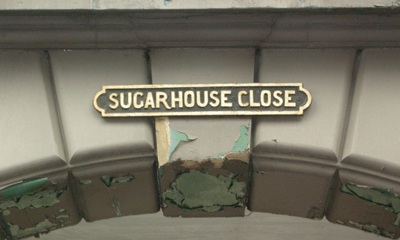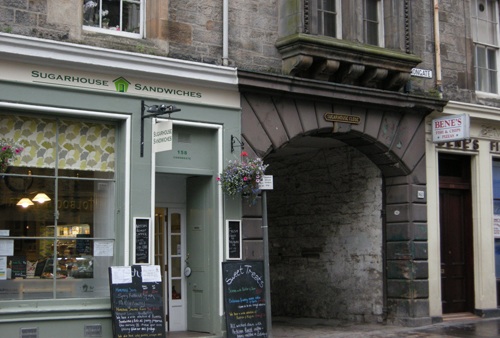SUGARHOUSE CLOSE, CANONGATE, EDINBURGH
The Edinburgh Sugar House Company - Minute Book 1752-63 & Account Book 1758-59
(Edinburgh Central Library - Y.HD.9111.8 - NRAS3563/125/1&2)
Notes from the Minute Book - 27 Apr 1752 to 26 Mar 1763
This book is an almost daily record of the internal running and the external management of the sugarhouse in Sugarhouse Close, Canongate, Edinburgh. Too much to take in during just a few hours research, I have attempted to obtain the important facts from the book, from which to get an idea of just how a small sugarhouse like this was run. Whilst I have always suggested that the majority of owners were not refiners and so left the day-to-day running to an experienced boiler and a foreman, these minutes show how the system worked ... the managers/owners appointed one from amongst themselves to be the "manager for the week", whose duty it was to visit the sugarhouse daily, check its smooth working and record what was going on that day.
The first week ...
Monday 27th April 1752 - Managers of The Edinburgh Sugar House Company - meeting held at the British Coffee House, Edinburgh.
Present were managers Robert Baillie, William Mercer, James Murray, Thomas Sharp & Archibald Stewart. Also present were William Alexander, Alexander Sharp and George Chalmers.
Tues 28th - Boiling sugars for lumps. 37 moulds filled. Pans charged with 4 tierces of sugar for lumps tomorrow.
Wed 29th - 39 moulds filled.
Thurs 30th - 43 moulds filled. Panman Terrol Mackanaly from London £12 for expenses and £30 per year.
Write to London for 3000 sticks, 1000 hoops, 4 dozen large and 2 dozen small eggbrooms, 30 bundles scale boards, 2 coal baskets, 9 pan stones.
Fri 1st - 38 moulds filled.
Sat 2nd - 41 moulds filled.
... and on ... extracts only, eg. moulds filled each day but I've only included 'highlights' ...
Aimed to buy sugar at no more than 34s per cwt.
Sugar from London merchant - 4 hogsheads each of St Christopher, Antigua and Jamaica.
Lime cistern found to be faulty.
Workmen - "Mr Knack, foreman, and his men".
Francis Kemptie clerk at Canongate, John Peat his under-clerk paid £15 per year.
Tues 12 May - 48 moulds filled. Small beer brewed Saturday for the men.
Sale of loaves - firsts £3.8s.0d per cwt, seconds £3.6s.0d per cwt, thirds lumps £3.3s.0d per cwt. molasses 16s per cwt.
John Peat given rooms to live in.
Wed 17 May - Advertising in local papers the sale of molasses.
Tues 23 May - Boiling for single loaves and brown candy loaves.
Out of 'the managers' a different one was appointed each week as 'manager for the week'.
June - Powder loaves sold at £4.4s.0d per cwt.
Thurs - 169 double loaves moulds and 41 single moulds filled.
Fri - 94 canary moulds filled for best lumps.
Sat - 103 lump moulds filled.
Fri 7 July - 258 single loaf moulds filled.
Tues 18 - 291 single loaf moulds filled.
Wed 19 - 245 double loaf moulds filled.
Mon 2 Oct - Syrup and scum this day filled. 42 bastard moulds filled.
Mon 9 - 254 doubles in afternoon. 358 singles.
Extra 700 single loaf moulds ordered.
* Pans charged in afternoons for boiling next day - morning boiling and filling, charged again in afternoon. *
4 Dec - 20 reams of 'sugar' paper from Holland.
Prices up in London, so prices increased - 4th powder 42s, 3rd powder 54s, 2nd powder 68s, lumps 72s, 75s, 78s, single loaves 82s, 84s, powder loaves £4.10s.0d, double refined 10d, 11d, 12d, brown candy 9d, molasses 14s.
20 Dec - New panman needed, but delayed by Knack (foreman over panman). Insurance needed - Sun Fire Office £700 house, £500 utensils, £2000 stock, total £3200.
3 Jan 1753 - 100 more bastard moulds ordered and 500 bastard mould hoops.
Thurs Feb 5 - 170 double loaf moulds and 10 white candy pots filled.
Cooper needed at 6s per week - Mr Bell.
26 Mar - Terrol the boiler/panman at last dismissed.
"Ordered the clerk to buy cloth fit for making frocks for the men".
"Met with a gentleman from Hull about the molasses and agreed a price".
Thurs 31 May - Clerk receiving sugar from ?Haxton of London.
Tues 13 June - 75 lump moulds filled, 141 singles.
Wed 4 July - 254 small singles filled.
Wed 18 July - 249 Singles filled.
3 pans filled 163 canary moulds for second lumps and 3 pans charged for boiling tomorrow.
Fri 24 July - 240 singles filled.
Sat 25 July - 233 singles filled.
Quality less because of lack of 'upstairs man' - Cunningham employed.
23 Sep - To pay 3 guineas for pipe for water to sugarhouse for one year.
11 Oct - No sugar boiled owing to scarcity of water.
Mon 3 Dec - 136 lumps, weight 23:0:15 was boiled in one pan for double refined and filled 222 double refined moulds.
Fri 14 Dec - Men employed claying sugars.
Sat 15 Dec - Men employed claying sugars.
24 Dec - 88 lump moulds filled.
25 Dec - Men employed upstairs.
26 Dec - New fire stones being placed under pans.
27 Dec - New fire stones being placed under pans.
28 Dec - 90 lump moulds filled.
29 Dec - 87 lump moulds filled.
31 Dec - 91 lump moulds filled.
1 Jan 1754 - 85 lump moulds filled.
Nov - Robert Baillie left the Company.
... continues like this ... now only the unusual ...
May 1758 - Dismissed Cameron and Duncan for fighting and doing mischief in the sugarhouse.
Mon 28 Aug 1758 - One of the stoves caught fire and burnt all the goods within it and the house being in such confusion that it prevented business ... melancholy accident ... clerk to notify Mr Baird agent for Sun Fire Office of this misfortune ... men were requested to sit up all night to prevent further danger. Walls of stove very weak now, had to be rebuilt before new arch could be built above.
Oct 1759 - It seems generally raw sugar supplied by London merchants Innes & Clerk ... however at this time poor sugar supplied ... 11 hogsheads of Jamaica proved 'average bad' and 10 hogsheads of St Kitts 'very bad' in the boiling ... demanded some allowance.
20 Oct 1760 - Charles Gib the Company's apprentice panman wished to be discharged from his indenture with loss of wages. Managers allowed this owing to his previous bad behaviour.
New managers listed as Alex Hunter, William Mercer, James Murray, James Hunter, Alexander Hunter, George Sandy. Also mentioned are William McFarlane, William Willie, James Scott.
Mar 1761 - Sugars to be sold at - treble loaves at 13d, double loaves at 12d per lb, powder loaves at 94s-98s, single loaves at 89s-91s, lumps at 82s-86s, powder 55s, 60s, 64s, 72s, 80s.
21 Jun 1762 - purchase/order from Innes & Hope of 400 lump moulds, 300 bastard moulds, 100 canary moulds, 300 single moulds, 100 double moulds. (no jars ?) And also questioning the best source of raw sugar requiring samples from London and Glasgow.
Feb 1763 - Prices of refined sugar have fallen considerably in London so priced reviewed.
Sample extracts from the Account Book - 18 Feb 1758 to 22 Nov 1759
* Prices, etc
First day ...
Sold old staves 1s.3d
11 loaves 2nd single 1.0.7 at 76s £4.0s.9d
molasses 3.1.0 at 30s £4.17s.6d
1 box brown candy 0.0.59 at 9d £2.4s.3d
2nd powder 1.0.0 at £2.17s.0d
3rd powder 1.0.0 at £2.13s.0d
5 loaves treble 0.0.33 at 11d £1.10s.3d
4 loaves double 0.0.29 at 10d £1.4s.2d
Second week ...
Bought 19 hogsheads Jamaica sugar 233.7.20 nett at £15 cwt £526.6s.9d
Sold 7 loaves 3rd lump 2.0.6 at 68s £6.19s.7d
4 loaves 2nd lump 1.0.23 at 70s £4.4s.4d
fine powder 1.0.0 at £3.3s.0d
4th powder 1.0.0 at £2.6s.0d
carriage for 124 hogsheads of sugar £9.18s.0d
10 loaves best single 1.0.0 at £4.0s.0d
12 loaves best single 1.0.12 at 78s £4.6s.4d
11 loaves best single 1.0.6 at 80s £4.4s.3d
Apr 1758 ...
Paid Wilkie for coals £7.8s.3d
Jun 1758 ...
blue paper from Holland £25.1s.6d
Nov 1759 ...
Sold -
4 loaves double 0.0.28 at 11½d £1.6s.10d
4 loaves lump 1.0.8 at 81s £4.6s.9d
2nd powder 1.0.0 £3.12s.0d
4th powder 1.0.0 £2.19s.0d
9 brown candy 0.0.68 at 11½d £3.5s.2d
11 loaves 2nd single 1.0.10 at 88s £4.15s.10d
molasses at 28s
3rd powder 1.0.0 at £3.5s.0d
5 best lump 1.0.1 at 85s £4.5s.9d
11 loaves best single 1.0.9 at 90s £4.17s.2d
second best lump at 84s
20 loaves 2nd single 2.0.4 at 88s £8.19s.1d
Bought -
5 hogsheads St Kitts 50.3.16 at 51s £129.15s.6d
15 hogsheads Jamaica 162.2.0 at 42s.6d £345.6s.3d
20 hogsheads Jamaica 222.2.21 at 46s £512.15s.1d
20 hogsheads St Kitts 231.3.13 at 50s £579.13s.9d
12 hogsheads Jamaica 138.3.26 at 44s £305.15s.2d
charges £14.8s.5d
commission £23.11s.11d
insurance £53.15s.6d
arrived on board the Glasgow Paisley packet, Capt Thomson
104 hogsheads shipped by Innes & Clerk of London
* Wages, etc
Second week ...
Paid Brine Brines (boiler) £4.0s.0d
Paid Niss Volquardson (panman) £2.0s.0d
1 Apr 1758 ...
Paid Francis Kemptie (clerk) salary Dec 25 to Mar 25 £12.10s.0d
Paid Brine Brines £4.0s.1d
Paid Niss Volquardson £3.10s.0d
Received from Niss Volquardson £1.4s.0d
27 Apr 1758 ...
Paid Brine Brines £2.0s.0d
20 May 1758 ...
Paid Brine Brines £5.0s.0d
Paid James Cunningham (upstairs man) a quarters wages £4.0s.0d
3 Jun 1758 ...
Paid Niss Volquardson £2.0s.0d
29 Jun 1758 ...
Paid Brine Brines £5.0s.0d
Paid Francis Kemptie £12.10s.0d
5 Aug 1758 ...
Paid Brine Brines £5.0s.0d
Paid James Cunningham a quarters wages £4.0s.0d
30 Aug 1758 ...
Paid Brine Brines £5.0s.0d
4 Sep 1758 ...
Paid Niss Volquardson £2.0s.0d
Nov 1759 ...
Paid Brine Brines £4.0s.0d
Paid Niss Volquardson £2.0s.0d






